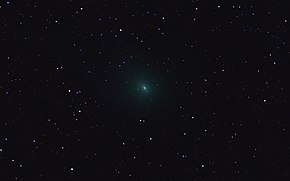


Comet Honda–Mrkos–Pajdušáková on February 10, 2017
| |
| Discovery | |
|---|---|
| Discovered by | Minoru Honda |
| Discovery date | December 3, 1948 |
| Orbital characteristics | |
| Epoch | 2011-Jun-08 (JD 2455720.5) |
| Aphelion | 5.511 AU |
| Perihelion | 0.5296 AU |
| Semi-major axis | 3.0205 AU |
| Eccentricity | 0.8246 |
| Orbital period | 5.25 yr |
| Inclination | 4.257° |
| Last perihelion | April 26, 2022[1] December 31, 2016[2] September 28, 2011[3] June 29, 2006[4][5] March 29, 2001 December 25, 1995 |
| Next perihelion | 2027-Aug-31[6] |
| Earth MOID | 0.06 AU (9,000,000 km)[3] |
| Jupiter MOID | 0.106 AU (15,900,000 km)[3] |
| Physical characteristics | |
| Dimensions | 1.3 km[7] |
45P/Honda–Mrkos–Pajdušáková is a short-period comet discovered by Minoru Honda December 3, 1948.[8] It is named after Minoru Honda, Antonín Mrkos, and Ľudmila Pajdušáková. The object revolves around the Sun on an elliptical orbit with a period of 5.25 years.[3] The nucleus is 1.3 kilometers in diameter.[7] On August 19 and 20, 2011, it became the fifteenth comet detected by ground radar telescope.[9]
During the 1995 perihelion passage, the comet was visible to Solar and Heliospheric Observatory (SOHO) on January 16, 1996, when the comet was around apparent magnitude 7 and 4.3° from the Sun.[8]
It is green because it emits diatomic carbon which glows green in the near vacuum of space.[10]
During the 2011 perihelion passage, the comet was recovered on 5 June at magnitude 21.[11] On 8 July, the comet had a magnitude of approximately 18,[12] and, as of 22 July, nuclear condensation was noticed around magnitude 16.[13] It was expected to reach a peak magnitude of around 7.3 in late September near perihelion.[14]
On August 15, 2011, the comet made a close approach of only 0.0600 AU (8,980,000 km; 5,580,000 mi) from the Earth[15][16][17] and it was studied by the Goldstone Deep Space Network.[18] Radar observations on August 19 and 20 detected echoes from the nucleus and coma.[9]
45P/Honda–Mrkos–Pajdušáková came to perihelion on December 31, 2016.[3] By February 4, 2017, it was around magnitude 7 and the coma was about 100,000 km across.[19] The comet required binoculars to be seen because of the low surface brightness.[20] The comet passed 0.08318 AU (12,444,000 km; 7,732,000 mi) from Earth on February 11, 2017, which was the same day as a lunar eclipse.[16][21]



|
| This shows the path of the comet during January through March 2017, with daily motion drawn as spheres, scaled for relative distance from earth. |
The next notable close approach will be in October 2032[16] when the comet might brighten to magnitude 7.
On 16 August 2022 the global CAMS and Sonotaco network detected a modest outburst of meteors with an orbit that resembled comet 45P.[22] The shower received the temporary designation of M2022-Q1, and was later permanently named the August Delta Capricornids.[23] The meteors had an entry speed of 24.4 km/s and originated from the border of Aquarius and Capricornus with R.A. 21:40 and a declination of –11.9°.[22] This was the first time an encounter with a dust trail of 45P has been confirmed and it came from the 1980 meteoroid stream of 45P.[23] In all, 137 meteors were triangulated by the global CAMS networks.
last obs. used: 2012-04-12
last obs. used: 2012-04-12
| Numbered comets | ||
|---|---|---|
| Previous 44P/Reinmuth |
45P/Honda–Mrkos–Pajdušáková | Next 46P/Wirtanen |